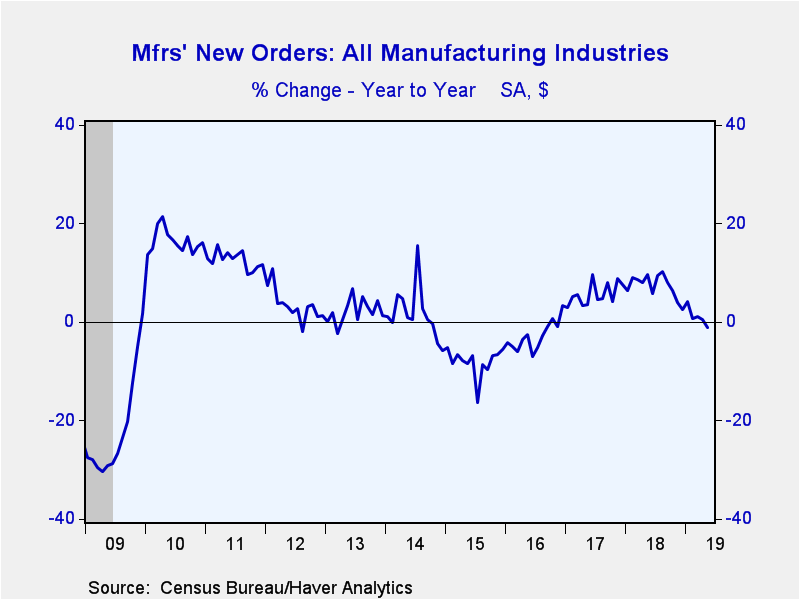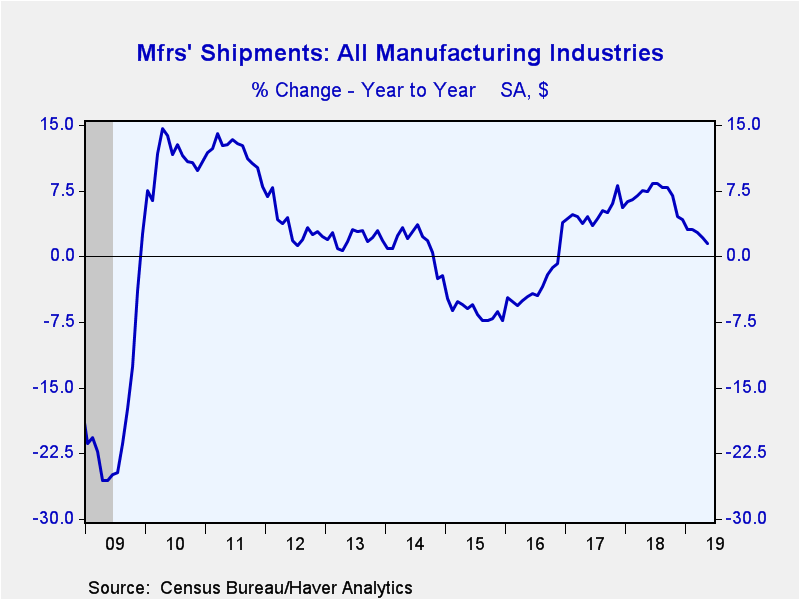 Global| Jul 03 2019
Global| Jul 03 2019Weak Factory Orders and Shipments Data
Summary
Manufacturers' orders declined a greater-than-expected 0.7% (-1.2% year-on-year) in May following a slightly downwardly-revised 1.2% drop in April (was -0.8%). The Action Economics Forecast survey looked for a 0.5% decrease. Factory [...]
Manufacturers' orders declined a greater-than-expected 0.7% (-1.2% year-on-year) in May following a slightly downwardly-revised 1.2% drop in April (was -0.8%). The Action Economics Forecast survey looked for a 0.5% decrease. Factory shipments edged up 0.1% (1.4% y/y) after contracting 0.6% in April (revised from -0.5%). Shipments of nondefense capital goods excluding aircraft, also known as core durable goods, which is one of the key inputs into nonresidential equipment investment in GDP, rose 0.6% in May (+4.0% y/y) and is currently growing at 1.5% annual rate for the quarter.
Orders in the volatile durable goods sector fell 1.3% (-2.8% y/y) after dropping 2.8% in April. This decline was driven by a 4.6% collapse in orders for transportation equipment (-8.4% y/y) as civilian aircraft orders plummeted 28.2% in May. While notoriously volatile on a monthly basis, these orders have fallen 56% over two months and 66% from a year ago. Total factory orders excluding transportation edged up 0.1% (0.4% y/y). Fabricated metal orders, the second largest category behind transportation, declined 0.3% in May (-0.4% y/y). This was offset by a 0.8% rise in machinery orders, the third largest category (0.3% y/y).
Shipments of durable goods grew 0.3% (2.4% y/y) with transportation increasing by the same amount (3.4% y/y). A 1.4% drop in civilian aircraft shipments (-26.0% y/y) was more than offset by a 0.5% gain in motor vehicles (9.5% y/y). Fabricated metal shipments increased 0.4% (2.6% y/y) and machinery rose 1.0% (2.5% y/y).
Nondurable goods shipments, which equal nondurable goods orders because nondurables are shipped in the same period they are ordered, decreased 0.2% (+0.4% y/y). This decrease was driven a 2.5% drop in shipments from petroleum refineries (-2.3% y/y). Energy prices, in particular oil prices, play a significant role on the value of energy product activity in this report. West Texas intermediate oil prices were down 4.7% in May (-5.2% after seasonal adjustment). Shipments for the largest nondurable category, food products declined 0.4% (-0.6% y/y), while basic chemicals the second largest by a hair, increased 0.9% (2.8% y/y).
Unfilled orders of durable goods, which as implied above equals unfilled factory orders, contracted 0.5% (+0.9% y/y) as transportation equipment backlogs fell 0.7% (+0.4% y/y). Excluding the transportation sector, unfilled orders decreased 0.2% (+1.9% y/y). Computer & electronic backlogs edged up 0.1% (3.3% y/y) while machinery was down 0.6% (-0.5% y/y).
Inventories of manufactured products rose 0.2% May (3.6% y/y) as durable goods inventories–which are roughly 60% of total inventories–grew 0.5% (5.0% y/y). Transportation increased 1.6% (6.9% y/y). Inventories outside of transportation edged down 0.1% (+2.8% y/y) with fabricated metals decreasing by the same amount (+4.0% y/y). Meanwhile, the machinery sector inventories swelled by 0.2% (5.7% y/y). Nondurable goods inventories declined 0.2% (+1.6% y/y) as petroleum refineries dropped 1.9% (-0.6% y/y) and food ticked down 0.1% (-1.1% y/y). Basic chemical inventories increased 0.1% (2.6% y/y).
All these factory sector figures and West Texas intermediate oil prices are available in Haver's USECON database.
| Factory Sector (% chg) - NAICS Classification | May | Apr | Mar | May Y/Y | 2018 | 2017 | 2016 |
|---|---|---|---|---|---|---|---|
| New Orders | -0.7 | -1.2 | 1.3 | -1.2 | 7.3 | 5.7 | -2.9 |
| Shipments | 0.1 | -0.6 | 0.2 | 1.4 | 6.9 | 5.0 | -3.2 |
| Unfilled Orders | -0.5 | -0.2 | 0.1 | 0.9 | 3.9 | 1.9 | -1.1 |
| Inventories | 0.2 | 0.2 | 0.4 | 3.6 | 3.5 | 4.5 | -0.7 |
Gerald D. Cohen
AuthorMore in Author Profile »Gerald Cohen provides strategic vision and leadership of the translational economic research and policy initiatives at the Kenan Institute of Private Enterprise.
He has worked in both the public and private sectors focusing on the intersection between financial markets and economic fundamentals. He was a Senior Economist at Haver Analytics from January 2019 to February 2021. During the Obama Administration Gerald was Deputy Assistant Secretary for Macroeconomic Analysis at the U.S. Department of Treasury where he helped formulate and evaluate the impact of policy proposals on the U.S. economy. Prior to Treasury, he co-managed a global macro fund at Ziff Brothers Investments.
Gerald holds a bachelor’s of science from the Massachusetts Institute of Technology and a Ph.D. in Economics from Harvard University and is a contributing author to 30-Second Money as well as a co-author of Political Cycles and the Macroeconomy.









